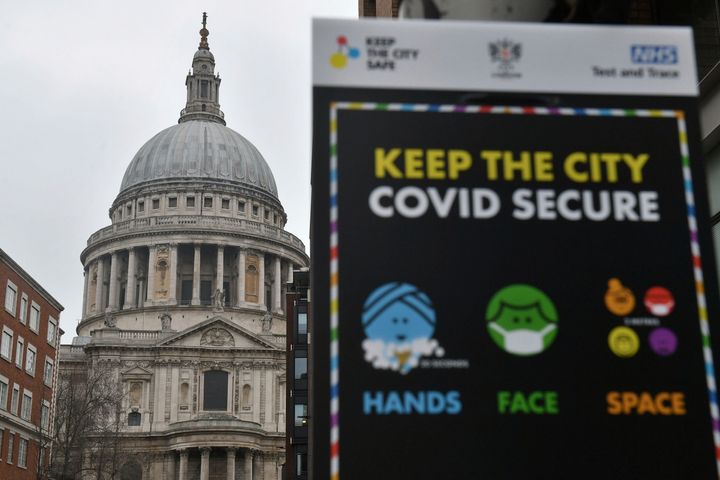Coronavirus cases are decreasing in all regions that went into tier 4 restrictions in December, while most other parts of England continue to see sharp rises, the latest NHS data show.
After a new and more infectious variant of the virus was discovered in Kent in November, Boris Johnson began moving areas into the tightest local rules, scuppering plans for the festive season for millions.
London and large areas of the south-east and east of England were put under the new rules just before Christmas, with more areas in those regions following on Boxing Day.
These regions are now showing a decrease in Covid cases – whereas almost all those that remained in tier 3, where Christmas household mixing was allowed to go ahead, albeit only for one day – continues to see an increase.
Cases are also down overall in the north-east, which didn’t enter tier 4 restrictions until New Year’s Day, though the decrease isn’t as pronounced.
The data below show the percentage change in cases during the seven-day period up to January 8 compared to the seven days up to January 7 – in other words, how the rolling average is changing.
The number in brackets is the number of cases per 100,000 people. For context, the government’s own threshold for quarantining overseas travellers is 20 cases per 100,000 people – meaning these figures are still extremely large even if they have slightly fallen.
Change in cases by region
- East of England -9% (704.7)
- South-east -7% (645.9)
- London -6% (958.4)
- North-east -2% (390.6)
- East Midlands 14% (445.1)
- South-west 14% (368.3)
- Yorkshire and The Humber 14% (323.0)
- West Midlands 23% (588.9)
- North-west 46% (612.1)
While the data are encouraging, overall infection numbers remain sky-high and a lag between infection and the onset of severe illness means hospitalisations and deaths will likely continue to rise for a number of weeks.
And as a whole, the reproduction number, or R rate, of coronavirus transmission across the UK has risen to between 1.0 and 1.4, according to the latest government figures released last week.
At a more localised level, of the 50 areas listed by NHS Digital that were covered by the tier 4 rules in December, only nine have seen an increase in cases for the same period.
Entered tier 4 on December 20 – rising cases
London
- Ealing 15% (1,054.1)
- Southwark 5% (974.5)
- Hillingdon 5% (1,011.2)
- Brent 5% (1,040.7)
- Kensington 2% (644.3)
East and South-east
- Reading 22% (736.2)
- Luton 20% (918.6)
- Peterborough 7% (505.3
- East Sussex 1% (728.6)
Entered tier 4 on December 20 – falling cases
London
- Richmond-upon-Thames -26% (487.8)
- Bromley -25% (850.3)
- Kingston-upon-Thames -22% (646.7)
- Sutton -21% (877.6)
- Havering -21% (1,056.1)
- Merton -20% (834.7)
- Tower Hamlets -14% (1,078.1)
- Barnet -11% (901.8)
- Redbridge -10% (1,299.1)
- Hackney and the City of London -9% (843.1)
- Wandsworth -8% (711.0)
- Bexley -8% (1,119.7)
- Camden -7% (624.4)
- Enfield -6% (1,154.6)
- Westminster -6% (544.9)
- Croydon -5% (1002.3)
- Barking and Dagenham -5% (1,488.5)
- Hammersmith -5% (706.5)
- Haringey -4% (1006.2)
- Islington -3% (765.5)
- Harrow -3% (831.3)
- Lewisham -2% (976.3)
- Waltham Forest -2% (1,109.1)
- Newham -2% (1,335.8)
- Greenwich -1% (1060.6)
- Hounslow -1% (1,085.0)
- Lambeth -11% (757.3)
East and South-east
- West Berkshire -21% (320.6)
- Essex -16% (949.0)
- Central Bedfordshire -16% (542.9)
- Milton Keynes -15% (805.3)
- Kent -13% (689.5)
- Hertfordshire -12% (741.4)
- Buckinghamshire -10% (618.2)
- Surrey -12% (658.4)
- Hampshire -5% (503.8)
- Bedford -1% (879.4)
On Boxing Day, more areas of the east and south-east of England were put under tier 4 restrictions. Cases in these areas are decreasing or flat in all but two.
Entered Tier 4 on Boxing Day – rising cases
- Suffolk 8% (484.9)
- Norfolk 1% (482.1)
Entered tier 4 on Boxing Day – decreasing cases
- Portsmouth -9% (562.6)
- Southampton -7% (577.4)
- Hampshire -5% (503.8)
- West Sussex -4% (632.8)
- Oxfordshire -4% (534.4)
- Cambridgeshire 1% (468.5)

Aside from the north-east, cases continue to rise overall in those areas that were under tier 3 restrictions or lower throughout December.
- In Yorkshire and The Humber, cases are increasing in 12 of 15 areas.
- In the north-west, cases are increasing everywhere except Cheshire East, where they are down 2%
- In the south-west, cases are increasing in 11 of 14 areas.
- In the East Midlands, cases are increasing everywhere except Lincolnshire, where they are down 1%.
- In the West Midlands, cases are increasing everywhere except Warwickshire, where they are flat.
Areas where cases are rising the fastest
- Knowsley 134% (1,400.6)
- St Helens 114% (836.7)
- Liverpool 110% (1035.7)
- Torbay 98% (243.6)
- Sefton 95% (1,035.1)
- Halton 81% (1,259.6)
- Telford and Wrekin 63% (538.8)
- Wirral 57% (953.4)
- Shropshire 53% (442.5)
- Salford 48% (442.5)
Meanwhile, a public health expert said on Sunday lockdown in the UK should continue for the next 12 weeks despite it being a “crude” approach to tackling the pandemic and “catastrophic” for the economy and mental health.
Professor Devi Sridhar, chair of public health at Edinburgh University, told Times Radio that harsh restrictions are the only viable option given the prevalence of Covid-19 across the country right now.
“With the numbers we’re at, there’s no other choice,” she said.
Prof Sridhar stressed a post-lockdown strategy must be put in place to suppress the virus going into the summer.
“For me, it’s a three-phase strategy – first is right now, it’s crude, it’s catastrophic for the economy and for people’s mental health, but: a lockdown. Get those numbers down, protect the NHS for the next 12 weeks,” she said.
“When we get into March and hopefully numbers are low again and we get into seasonal change, get your testing and tracing and your border measures in place to really suppress.
“And then in the summer, instead of taking your foot off the gas and saying: ‘Let’s open up everything,’ actually think: ’How do we prevent this winter from happening again? How do we actually protect that low prevalence, get emergency teams in place in case there are flare ups? Go in, have a quick, sharp one-week lockdown and get your testing and tracing to clear the virus.”
